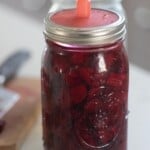
Fermented Beets
Fermented beets are a crunchy and delicious snack, a colorful and nutritious side dish, and a bright and easy topping for a variety of dishes.
Servings 10
Calories 23kcal
Ingredients
- 2 large beets organic beets are best
- 4 cups water filtered
- 2 tablespoons salt, Himalayan or sea salt not iodized
Instructions
- Stir two cups of filtered water in a saucepan with two tablespoons of salt, warming over low-medium heat just until dissolved.
- Pour the salt water into a clean quart jar.
- Add remaining 2 cups of water to the salt water mixture,.
- Slice beets into bite-sized cubes and add to your empty quart jar with desired seasonings (garlic, peppercorns, etc). Layer beets and seasonings to really disperse the flavors.
- Pour your salt brine over the beets until fully submerged. Leave 1-2 inches at the top of the jar. You can use a fermentation weight or improvise with a smaller, clean jar or even a large, folded cabbage leaf to keep the submerged beets in place.
- Extra brine can be reserved in your refrigerator until the next ferment.
- Cover with a fermentation lid, or even a loosely placed canning lid or tea towel. You want to protect your fermentation while allowing air to be released. If using a regular canning lid, open the jar once a day to release the gas.
- Leave the jar at room temperature for 2-10 days until your desired flavor and texture is achieved.
- Once your ferment is done, cover with a tight lid and move to the refrigerator.
Notes
- Filtered water is important for maintaining the beneficial bacteria in a brine. Tap water contains chlorine which kills bacteria, the good and the bad, so it's best to avoid using tap water. You can also boil tap water on the stovetop for 15 minutes. Be sure to let it cool before use, as hot water can kill the beneficial bacteria on the vegetables.
- Rinse your vegetables using filtered or unchlorinated water, as well.
- Pack those jars full! You want to maximize the jar capacity for the ferment.
- Cut the tops and bottoms off the beets to prep. You can peel the beets, but I find this step unnecessary. Also, don't waste your beet greens! They are delicious sautéed in olive oil or butter.
- I use 1 tablespoon of salt for every 2 cups of water in this brine. So for this recipe, I'm using a quart jar and 2 tablespoons of salt. I've used the same recipe with larger ratios for fermented carrots, making a half gallon and using 4 tablespoons of salt.
- A quart jar packed with veggies takes a bit over 2 cups of brine, so I make a full quart of brine and save the extra brine in the fridge for the next ferment.
- The vegetables should be fully submerged in the brine. If any are are poking up above the brine, they can mold, ruining your whole batch.
- You can easily experiment with flavors! Add cloves of garlic and peppercorns, bay leaves, mustard seeds, or fresh dill, for a savory option. Fresh beets are naturally sweet, so you can complement that sweetness with cinnamon and cloves. Try adding hot peppers or chili flakes. There are so many options!
Nutrition
Calories: 23kcal | Carbohydrates: 5g | Protein: 1g | Fat: 0.1g | Saturated Fat: 0.01g | Polyunsaturated Fat: 0.03g | Monounsaturated Fat: 0.02g | Sodium: 1442mg | Potassium: 177mg | Fiber: 2g | Sugar: 4g | Vitamin A: 18IU | Vitamin C: 3mg | Calcium: 12mg | Iron: 0.4mg